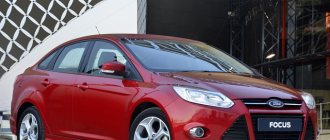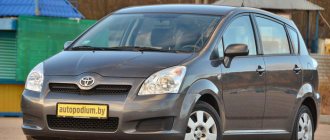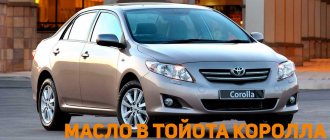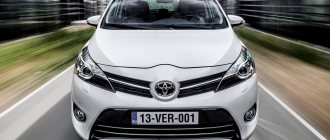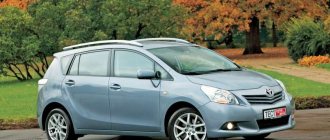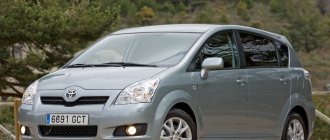4402 Apr 20
The Japanese automaker, releasing the Toyota Corolla Spacio compact van onto the domestic market, was primarily targeting car enthusiasts from Asian countries who needed a small family car to transport a large family. The first generation of the Toyota Corolla Spacio 1997 model series was developed on the platform of the hatchback of the same name, which is clearly visible in the photo, and received similar technical characteristics, thanks to which it quickly gained popularity in the Asian market.
The dream of family car enthusiasts has finally come true!
Toyota corolla spacio 2002 is a compact front-wheel drive car that will appeal to car enthusiasts who have long dreamed of a minivan, but are forced to give up buying one due to its high cost or large dimensions, which make daily use of the car difficult in urban environments. Corolla Verso appeared relatively recently on the domestic car market, but during this time it has managed to win the sympathy of car enthusiasts who cannot deny themselves the pleasure of going on vacation with a large family or a large company.
First generation compact van
The first generation of the Toyota Corolla Spasio 1997 minivan, intended for the domestic market, was produced exclusively with a right-hand steering column and, thanks to the enlarged glazing of the body, had excellent visibility, which was further enhanced by the high seating position of the driver's seat.
Toyota Corolla Spacio 1997 model series, in accordance with the prefix Spasio to the name of the car, which means “free space” in English, received increased weight and dimensions compared to the popular hatchback. Their indicators:
- The length of the car was 4135 mm;
- The width of the car was 1690 mm;
- The height of the car body was 1620 mm;
- 2465 mm – wheelbase size;
- 150 mm – clearance height from the body to the road surface.
The line of power units with which the family compact van was equipped included two gasoline engines; a description of their characteristics looks like this:
- in-line four marked 4A-FE with a 1.6 liter displacement, with a power of 110 horses or 81 kW, achieved at 5800 engine speeds, and a maximum torque of 149 Nm at 4600 revolutions;
- in-line four marked 7A-FE with a 1.8 liter displacement, with a power of 120 horses or 88 kW, achieved at 6000 engine speeds, with a maximum torque of 157 Nm at 4800 revolutions.
Each of the engines was paired with a four-speed automatic transmission and was either front-wheel drive with a 1.6-liter engine, or all-wheel drive, included in the technical equipment of a compact van with a 1.8-liter power unit.
There was no great variety in the configurations of the first cars, and they differed only in the displacement of the engine and the type of drive to either the front or rear wheels of the minivan. The Toyota Corolla Spasio model of the 1998 model year received more expanded options for equipping with additional options.
Stylish design and reliable protection for passengers
The appearance of the Toyota Corolla Verso 2002 is radically different from the exterior of its predecessors. The car body, which you can see in the photo below, consists of two separate sections: the lower one, which includes the bumper and wheels, is more reminiscent of an SUV in terms of technical characteristics and ensures excellent movement of the compact van on any road. The upper part - a streamlined roof, the characteristic shape of the rear side windows and the rounded protrusion on the hood typical of all Toyota Corolla models - gives the car a stylish look and improves its speed and maneuverability. The innovative design of the Toyota Corolla Verso did not go unnoticed: it was officially announced that the aerodynamic drag coefficient of the car is 0.3, which is the best indicator among compact vans.
The stylish design of the Corolla Verso does not in any way affect the technical characteristics and safety of the car: according to this indicator, the car takes first place in its group. The design of the compact van is built into a protection system developed by Toyota, which is well known to the owners of Toyota Avensis and has shown excellent results in numerous crash tests. 9 airbags provide protection for those present in the cabin in the event of an accident, and a built-in sound and light warning system for unfastened seat belts will provide increased safety for forgetful drivers and passengers. Improved brakes that have a positive reputation among Toyota Avensis owners will reduce the risk of an accident to a minimum.
Modern interior will provide increased travel comfort
The main advantage of the Corolla Verso is its comfortable, unusually spacious interior, which can easily accommodate seven adults. The built-in Easy Flat 7 system gives a wide range of possibilities to change the position of the seats, further increasing the interior space of the car. In total, the Corolla Verso's seats can be positioned in thirty-two different ways! Moreover, changing the layout of the car does not require serious skills - you can fold down the five rear seats, obtaining a flat surface with one movement of the hand (see photo).
The third row of the Corolla Verso is slightly cramped and is not designed for constant use - for the constant transportation of a large number of people, there are a large number of classic minivans with higher engine power and minibuses, and in terms of its technical characteristics, the Corolla Verso is more of a multifunctional car.
Depending on the location of the seats, the trunk volume can vary significantly: from 91 liters in standard form to 779 liters with the seats folded down!
Toyota Corolla Verso designers, rightly believing that driver comfort is the key to a pleasant trip, provided him with ample opportunities to organize his seat: change the height of the front seats in the range of 52 mm, the tilt and reach of the steering wheel.
The car is started using the engine start button and an electronic key card. The key card has a small mechanical key built into it that opens the driver's door and glove box, and also disables the airbag near the passenger seat.
The multifunctional display of the Toyota Verso, showing all driving parameters: remaining and average fuel consumption, travel time and average speed, is located on the dashboard, and not on the console, like its predecessors - this arrangement is much more practical and convenient from an ergonomic point of view. When the ignition is started, the dashboard is illuminated with a light green light - no worse than a higher-class Toyota car!
Technical equipment of the second generation minivan
This model, which was released in 2001, had both a right-hand drive for the domestic market and a left-hand drive intended for delivery to America, where it quickly managed to gain increased popularity among local minivan car enthusiasts.
The second generation of the 2001 Toyota Corolla Spacio modification received completely updated body elements, head optics lighting devices, which is well reflected in the photo of the car, and new technical equipment, the review of which should begin with the line of power units and interior layout.
The 2001 Toyota Corolla Spacio received new engines designed for economical fuel consumption and compliance with strict environmental requirements in both the domestic and American markets. Motor characteristics:
- The 1.5-liter in-line petrol four, marked 1NZ-FE and with a new VVT-I gas distribution system, has a power of 110 horses or 81 kW, achieved at 6000 engine speeds, and a maximum torque of 143 Nm at 4200 revolutions;
- 1.8-liter in-line gasoline four labeled 1ZZ-FE with a new VVT-I gas distribution system, power was 125 horses or 92 kW, achieved at 6000 engine speeds, maximum torque of 161 Nm at 4200 revolutions.
In tandem with the engines, the manufacturer has included a slightly modernized automatic transmission with four stages, which has drive on the front axle when equipped with a 1.5-liter engine and on both axles when equipped with a 1.8-liter engine.
The weight and dimensions of the car body, which received the new designation Toyota Corolla NZE121, have also changed significantly. The dimensions are as follows:
- The Corolla reached 4240 mm in length in 121 bodies;
- Its width was equal to 1695 mm;
- The height of the second generation model was 1610 mm;
- 155 mm was equal to the ground clearance of the car;
- 2600 mm was the size of the wheelbase.
In the interior, significant changes affected the instrument panel, which now has completely analog indicators for the tachometer, odometer, engine operating temperature and fuel level, replacing the digital dashboard in the previous generation car. Another innovation was a new multimedia system with navigation support, which was equipped with a modification of the 2002 Toyota Corolla Spasio.
The 2002 Toyota Corolla Spacio's seating arrangement has been designed to accommodate 7 people in a 2, 3 and 2 configuration, which is 1 more than the first generation model. Due to the fact that the automatic transmission gear shift knob is located on a special ledge in the center console, the driver has access to a free transition to the passenger seat and second-row seats.
This modification of the compact van was produced until 2003, at the beginning of which the manufacturer carried out a slight restyling of the model, which resulted in the entry into the market of the Toyota Corolla Spasio 2003 model series.
The main feature of the restyled version was the minivan's increased ground clearance to 165 mm and its configuration options with additional options in the form of an electronic emergency braking assistant BAS and an ABS system, which significantly enhanced the active safety of all vehicle passengers.
Control Specifications
Would you say that a seven-seater minivan must have a remarkable engine in order to successfully withstand its loads? And you will be absolutely right! Toyota engineers took care of the technical characteristics of the Corolla Verso, equipping it with a 16-valve 1.8-liter engine with a capacity of 129 horsepower, which the owners of the well-known Toyota Avensis have already become familiar with. Of course, carrying seven passengers, the Corolla will not be able to demonstrate to us all the capabilities of its miracle engine, but if four people, including the driver, are traveling in the cabin, they will be pleasantly surprised by the speed and maneuverability of the Toyota Corolla Verso.
Toyota engineers offer the driver a five-speed manual electric transmission that combines automatic and quick shifting capabilities. The technical characteristics of the box allow it to operate in five standard modes N-5 (neutral-fifth gear), reverse (R), auto mode (E), sports auto mode (Es) and manual (M). Urban conditions allow the Toyota Corolla Verso to move in automatic mode, but here reckless drivers are in for a surprise - when you press the gas sharply, the box shifts to a lower gear with a sharp jolt. To avoid this inconvenience, we recommend either gently pressing the accelerator or driving with “manual” control.
Review of Toyota Corolla Spacio 1.6 (1998)
I didn’t dream about this car, I was considering a bunch of options, at the time of purchase I was limited in funds, and the car was really needed. A friend recommended a right-handed one, and I also needed my wife’s consent, since I’m also a driver;)) I took it without driving in Russia. First we sat in the back seat, checked the capacity, since besides my wife there are 2 more sons, one is more than 190 cm tall and both have size 45 feet - it passed the test. We started it, listened to how it worked and drove, and bought it. 9 years have passed, but I took it with the expectation of 2-3 years. I already bought a new car for my son and started looking at dealerships for a replacement. I asked my neighbor in the garage, he works at TOYOTA, what can I get as a replacement now. The answer was amazing - you can’t replace this one, only a CRUISER, the rest is g...
Now about the car:
The view is for an amateur, from the back and side it’s not very good - it’s Japanese, from the front it’s ok. The interior is excellent in terms of spaciousness (I don’t have a third row), transformation is a matter of seconds and there is a kitchen table with legs that are not unscrewed inside. Noise insulation is acceptable, you can’t hear the engine up to 100, then the wind starts to blow. I agree, there is windage, especially when a large truck comes close at high speed. Consumption _ I read on some forums about the high consumption - I completely disagree. The service life is long, I have a mixed cycle, 50 km to work. Sometimes 40 minutes, sometimes 3 hours or more. 7.5 -8.5 liters, on the highway it’s also rare to have less than 7 liters, because you won’t drive 110 km and no more :) After buying the car, I filled the gasoline with 95, then only 92, according to the passport it is 92-95-98. The quality of gasoline does not affect performance; it runs on anything as long as it burns.
Reliability. I haven't let you down the entire time. Cold winter (but I changed the battery, it probably came from a motorcycle when I bought it), mountains, snow. Didn't get stuck, didn't stall anywhere. There are also no complaints about the electrics, ABC, lighting, lifts, mirrors - everything is OK. This spring, on a hot day, to my surprise, cold air did not blow from the air conditioner; I had to refill the air conditioner for 1000 rubles. I didn’t go into the engine or gearbox, I changed consumables and once the front struts. Spare parts are everywhere and inexpensive. I ended up in body repair three times; OSAGO always had enough money for spare parts and repairs (not at a certified service). People who were not local “met” with me: an Adyghe, a Chinese and a person of... nationality. The craftsmen liked the iron: it was soft and straightened well. No signs of corrosion have been noticed in any places yet. The ergonomics are excellent, you don’t notice it until you get into another car, here everything you need is at hand. The display readings are hard to see during the day, because... you have to turn on the light and the display backlight automatically decreases, but it is not particularly needed; if the warning signs light up, you can see it. By the way, the “wheel deflation” indicator receives a signal not from a decrease in pressure, but from the difference in the rotation of the wheels - inflated and deflated; it takes some time for it to turn on and, accordingly, you need to drive a little for it to go out after replacing the wheel or pumping it up.
I like the ride quality, soft, response is normal for its power, very maneuverable. Small on the outside and huge on the inside, you understand why if you look at it from above, from the tenth floor. In terms of dimensions it seems smaller than our nine, but another nine will fit inside.
PS When I went to showrooms, managers asked when you expected to buy a car, I pointed to my Jap and said: if it breaks down, then we’ll come straight to you. YOU CAN’T WAIT FOR THIS, was the answer from managers in more than one salon. Nowadays cars don't do that. While I continue to drive my SPASKA, I don’t want to sell a working car for pennies, and I can’t choose a new one, although I won’t consider anything less than a lemon.
Good luck on the roads, love your iron horses, although they are iron, they will reciprocate!


